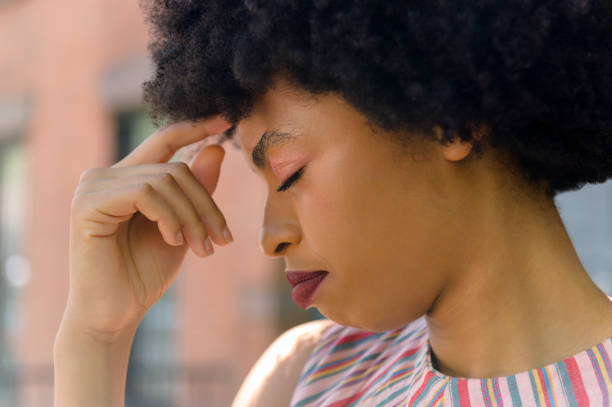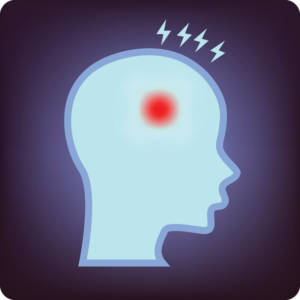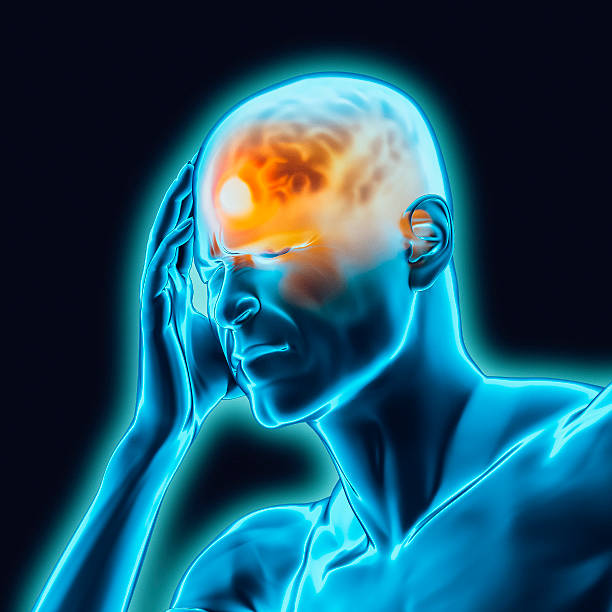
Understanding the meaning of your headache location can provide important clues about what’s causing your pain. Headaches don’t all feel the same—and where the pain is centered can often point to different underlying issues. For example, a headache in the front of your head, or a frontal headache, may indicate tension, eye strain, or sinus problems. In contrast, pain on the sides of your head near your temples is commonly associated with migraine headaches or temporal arteritis.
If you experience a headache in the back of your head, it might be related to neck tension, poor posture, or even occipital neuralgia—a condition where the nerves that run from your spine to your scalp become inflamed. Pain located in the center or top of the head may suggest different causes, such as tension headaches or, in rare cases, more serious conditions like high blood pressure or a vascular issue.
This article will break down the most common headache locations—including pain in the forehead, temples, back of the head, and top of the head—and what each one could potentially mean. By identifying the location of your headache, you can better understand the root cause and seek the right treatment or lifestyle changes.
According to the National Headache Foundation, over 45 million Americans suffer from headaches and of these, 28 million suffer from migraines.
What Do Your Headache Locations Mean?
There are several types of headaches; in fact, according to the National Headache Foundation, there are 150 different types of headaches. Looking at this headache chart and the content below, you can generally determine what type of headache you have depending on where exactly the pain is:
The most common headaches are migraines, tension headaches, and cluster headaches. They can be the result of illness, injury, or a problem elsewhere in the body. They can also occur from stress and emotional tension, overexertion, or even dietary issues.
Headaches can be anything from harmless to dangerous. Here’s how to tell:
READ: Tension Headache 101
Headache Location Meaning and Causes
Headache in the Front of your Head
- Tension headache
- Migraine
- Eye strain
- COVID headache
- Sinus headache
- Dehydration headache
A headache in the front of your head, often called a frontal headache, can be caused by a variety of factors. One of the most common is a tension headache, which feels like a tight band across the forehead and is often triggered by stress, poor posture, fatigue, or eye strain. Speaking of eye strain, spending long periods on screens or reading without breaks can also lead to aching in the forehead, especially if your vision needs correcting. Another possibility is a sinus headache, which causes pressure and pain in the forehead and is often accompanied by nasal congestion or facial tenderness, particularly during a sinus infection. Migraines can also cause frontal head pain and are usually more intense, sometimes accompanied by nausea, light sensitivity, and visual disturbances. Other common triggers include dehydration, lack of sleep, and caffeine withdrawal, all of which can lead to throbbing or pressure-like pain in the forehead. While many frontal headaches are mild and temporary, you should consult a doctor if the pain is severe, comes on suddenly, or is accompanied by symptoms like fever, confusion, or vision changes.

Headache location meaning (Temples (side of your head))
- Tension headaches
- Ice-pick headache
- Cervicogenic headache
Headaches that occur on the side of the head, particularly in the temples, can stem from several common causes. One of the primary culprits is a tension headache, which often creates a dull, aching pain that wraps around the head and settles in the temples, triggered by stress, anxiety, or muscle strain in the neck and shoulders. Migraines are another major cause, frequently starting with throbbing pain in one temple and possibly spreading, often accompanied by nausea, light sensitivity, or visual disturbances. Temporal arteritis, a more serious condition typically seen in older adults, involves inflammation of the arteries in the temples and can cause persistent, localized pain, scalp tenderness, and even vision problems. Additionally, teeth grinding or jaw clenching—often related to temporomandibular joint (TMJ) dysfunction—can lead to temple pain, especially if the pain worsens while chewing or talking. In some cases, cluster headaches, though less common, can cause severe, stabbing pain around one temple and eye, often occurring in cycles. Identifying the exact cause often depends on accompanying symptoms and patterns of the headache.
Headache location meaning (Back of the head)
- Cervicogenic headache
- Tension headache
- Dehydration headache
A headache at the back of the head, also known as an occipital headache, can be caused by several factors. One of the most common is tension, which often originates from tight neck and shoulder muscles due to stress, poor posture, or long periods of sitting, especially at a desk or computer. These headaches typically cause a dull, aching pain at the base of the skull that may spread upward. Another possible cause is occipital neuralgia, a condition where the occipital nerves become irritated or inflamed, resulting in sharp, shooting pains in the back of the head and upper neck. Cervicogenic headaches, which are triggered by issues in the neck such as arthritis, disc problems, or injury, can also cause pain that radiates from the neck to the back of the head. Additionally, high blood pressure can sometimes present as a headache in this area, particularly if it becomes dangerously elevated. Identifying the specific cause often involves considering other symptoms, lifestyle habits, and any underlying health conditions.
Headache location meaning (Middle/Top)
- Tension-type headache
- Ice pick headache
- Cough headache
- Exertion headache
- Coital (intercourse) headache
Headaches felt on the top or middle of the head, often described as a “crown” headache, can be caused by various physical and lifestyle factors. One of the most common causes is a tension headache, which creates a sensation of pressure or tightness across the scalp and may feel like a heavy weight sitting on the top of the head. Poor posture, especially when sitting or looking down for long periods, can strain the muscles in the neck and upper back, contributing to this type of pain. Dehydration, lack of sleep, and skipping meals are also common triggers that can lead to discomfort at the crown of the head. In some cases, migraines may begin or spread to the top of the head, often accompanied by other symptoms like light sensitivity or nausea. Less commonly, a headache in this area could be related to scalp tension, tight hairstyles, or even a condition called vertex headache, which refers specifically to pain at the very top of the skull. Pinpointing the exact cause usually requires looking at additional symptoms, duration, and lifestyle patterns.
Headache location meaning (One Side)
- Migraines
- Cluster headaches
Headaches that occur on one side of the head—either left or right—are often associated with specific types of headache disorders. Migraines are a leading cause and frequently produce throbbing or pulsating pain on one side, along with nausea, sensitivity to light or sound, and sometimes visual disturbances known as auras. Cluster headaches, though less common, are another cause and are known for their excruciating, stabbing pain that typically affects one side of the head, often around the eye, and can occur in cyclical patterns or “clusters.” Tension headaches can also present as one-sided pain, though they are more commonly felt on both sides. Additionally, sinus infections or inflammation can cause one-sided pain if only one sinus cavity is affected, particularly around the forehead or cheek. Conditions affecting the jaw, like temporomandibular joint (TMJ) dysfunction, or nerve-related issues such as occipital neuralgia, can also lead to localized, one-sided head pain. Identifying which type of headache you’re experiencing depends on the nature of the pain, accompanying symptoms, and frequency of episodes.
RELATED: Dangerous Headaches To Watch Out For

Types of Headaches and Locations
Cervicogenic headaches, one of the most common headache causes, in the back of the head. These headaches stem from the joints at the top of the neck.
Cluster headaches, which affect more men than women, are recurring headaches that occur in groups or cycles. They appear suddenly and are characterized by severe, debilitating pain on one side of the head, and are often accompanied by a watery eye and nasal congestion or a runny nose on the same side of the face.
COVID headache locations are something everyone is paying attention to nowadays due to the coronavirus. In some patients, the severe headache of COVID-19 only lasts a few days, while in others, it can last up to months. It is mostly felt around your whole head, with a severe-pressure type of pain. It’s different than migraine, which by definition is unilateral throbbing with sensitivity to light, sound, or nausea. This is more of a whole-head pressure presentation.
Coital headaches, also known as “sexual headaches,” occur at the base of the skull before orgasm during sexual activity. These headaches usually have an immediate onset, with some gradually worsening during sexual intercourse. They typically last for a few minutes to a few hours.
Dehydration headaches may occur at the front or back or just on one side of the head, or they may be felt throughout the entire head. Bending the head down or moving it from side to side often worsens the headache. Simply walking can cause more head pain.
Exertion headaches occur during or after sustained, strenuous exercise. Activities associated with exercise headaches include running, rowing, tennis, swimming and weightlifting.
Ice-pick headaches will often cause repeated sharp pains in the temples.
Migraines tend to cause one-sided pain, throbbing pain, moderate-to-severe pain, and pain that interferes with, is worsened by, or prohibits routine activity. Additionally, nausea and/or vomiting, and sensitivity to light and sound can accompany pain.
Sinus headaches are associated with a deep and constant pain in the cheekbones, forehead, or bridge of the nose. The pain usually intensifies with sudden head movement or straining. The pain is usually accompanied by other sinus symptoms, such as nasal discharge, the feeling of fullness in the ears, fever, and facial swelling.
Tension headaches, the most common type of headache, feel like a constant ache or pressure around the head, generally on both sides of the head.
In addition to the headache locations above, here’s what other headache locations mean:
Caffeine-Withdrawal Headaches
- Symptoms: Throbbing headache caused by rebound dilation of the blood vessels, occurring multiple days after consumption of large quantities of caffeine.
- Precipitating Factors: Caffeine
- Treatment: Treat by terminating caffeine consumption in extreme cases.
- Prevention: Avoiding the excess use of caffeine.
And what about those everyday headaches that seem to come back? No matter what the headache locations are, here’s what it means:
Chronic Daily Headaches
- Symptoms: Refers to a broad range of headache disorders occurring more than 15 days a month; two categories are determined by the duration of the headache (less than four hours and more than four hours).
- Precipitating Factors: Typically evolve from transformed migraine. Although not related to chronic tension-type headaches, they can evolve from episodic tension-type headaches. Can be associated with medication overuse.
- Treatment: Depending on the type of CDH, different treatment options exist. It is important to limit analgesic use.
- Prevention: Based on the diagnosis of headaches, how long they last, and the number experienced per month.









